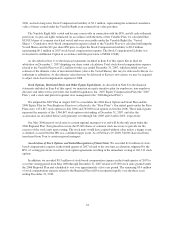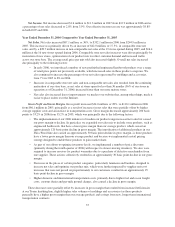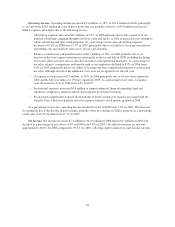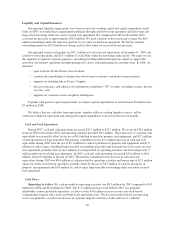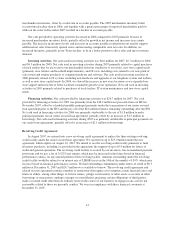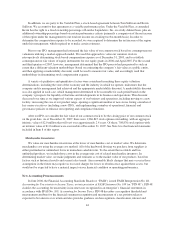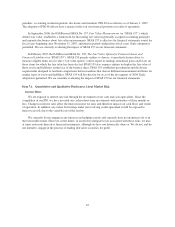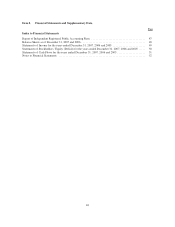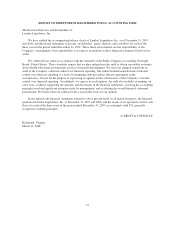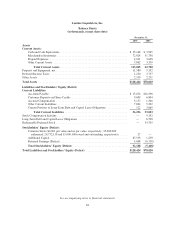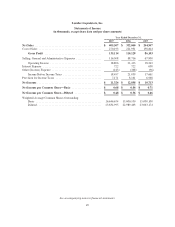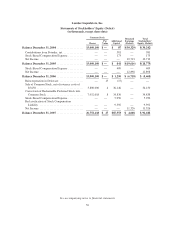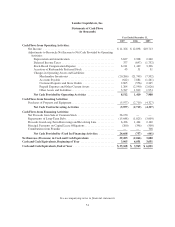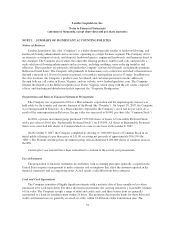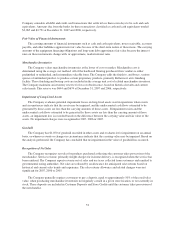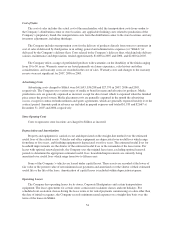Lumber Liquidators 2007 Annual Report Download - page 50
Download and view the complete annual report
Please find page 50 of the 2007 Lumber Liquidators annual report below. You can navigate through the pages in the report by either clicking on the pages listed below, or by using the keyword search tool below to find specific information within the annual report.In addition, we are party to the Variable Plan, a stock-based agreement between Tom Sullivan and Kevin
Sullivan. We account for that agreement as a variable performance plan. Under the Variable Plan, as amended,
Kevin has the right to a fixed ownership percentage of Lumber Liquidators, Inc. on a fully diluted basis, plus an
additional ownership percentage based on certain performance criteria (primarily a comparison of the net income
of the region under his management to our total net income on a trailing twelve-month basis). In order to
determine the compensation expense to be recorded, we were required to determine the net income of the region
under his management, which required us to make certain estimates.
Prior to our IPO, management had estimated the fair value of our common stock based on contemporaneous
valuations utilizing a market-approach model. We used this approach to value our common stock in
retrospectively determining stock-based compensation expense as of December 31, 2005, and to establish
contemporaneous fair values of equity instruments for our equity grants in 2006 and April 2007. For the second
and third quarters of 2007, however, management determined that the IPO process had progressed to such an
extent that a different valuation methodology (based on estimating the company’s fair value as a public entity,
and then applying a marketability discount) could be used to measure fair value, and accordingly used that
methodology in determining stock compensation expense.
A variety of qualitative and quantitative factors were considered in making these equity valuation
determinations, including the state of the economy and the industry in which we operate, milestones that the
company and its management had achieved and the appropriate marketability discount. A marketability discount
was also applied in each case, which management determined to be reasonable for each period based on the
company’s prospects for liquidity at that time and developments in its business and operations. This discount
decreased over time as we improved various aspects of our business and operations, including moving to a new
facility, increasing the size of our product range, opening a significant number of new stores, hiring a number of
key senior executives (including a new CEO), and implementing a number of operational, financial and
governance policies to enhance our reporting and compliance functions.
After our IPO, we consider the fair value of our common stock to be the closing price of our common stock
on the grant date. As of December 31, 2007, there were 1,966,847 stock options outstanding, with an aggregate
intrinsic value of $2.0 million that will vest over approximately 2.4 years. Of these, 708,876 stock options with
an intrinsic value of $1.0 million were exercisable at December 31, 2007. See Note 6 to the financial statements
included in Item 8 of this report.
Merchandise Inventories
We value our merchandise inventories at the lower of merchandise cost or market value. We determine
merchandise cost using the average cost method. All of the hardwood flooring we purchase from suppliers is
either prefinished or unfinished, but is in immediate saleable form. To the extent that we finish and box
unfinished products, we include those costs in the average unit cost of related merchandise inventory. In
determining market value, we make judgments and estimates as to the market value of our products, based on
factors such as historical results and current sales trends. Any reasonably likely changes that may occur in those
assumptions in the future may require us to record charges for losses or obsolescence against these assets, but
would not be expected to have a material impact on our financial condition or operating performance.
New Accounting Pronouncements
In June 2006, the Financial Accounting Standards Board (or “FASB”) issued FASB Interpretation No. 48,
Accounting for Uncertainty in Income Taxes, an interpretation of FASB Statement No. 109 (or “FIN 48”). FIN 48
clarifies the accounting for uncertainty in income taxes recognized in an enterprise’s financial statements in
accordance with SFAS No. 109, Accounting for Income Taxes. FIN 48 describes a recognition threshold and
measurement attribute for the financial statement recognition and measurement of a tax position taken or
expected to be taken in a tax return and also provides guidance on derecognition, classification, interest and
44


